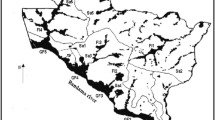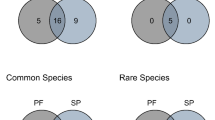Summary
Ant communities in Vermont and New York woods were sampled in four time periods to determine species composition, relative abundances, and nest locations in space. The Vermont community was richer, containing more species and higher nest densities than New York. Both communities followed the geometric distribution of species abundances, suggesting that a single resource was mediating competition. The resource most clearly implicated was suitable nest sites, principally pre-formed plant cavities. Nonrandom species associations, underdispersion in every season, and the occurrence of incipient nests overwintering aboveground all implicated shortage of such cavities. Furthermore, microhabitat differences which produce suitable nest sites occur over a very small scale in these communities.
Similar content being viewed by others
References
Alloway TM, Buschinger A, Talbot M, Stuart R, Thomas C (1982) Polygyny and polydomy in three North American species of the ant genus Leptothorax Mayr. (Hymenoptera: Formicidae). Psyche 89:249–274
Andersen AN (1986) Diversity, seasonality and community organization of ants at adjacent heath and woodland sites in southeastern Australia Aust J Zool 34:53–64
Briese DT, Macauley BJ (1980) Temporal structure of ant community in semi-arid Australia. Aust J Ecol 5:121–134
Brown JH, Reichman OJ, Davidson DW (1979) Granivory in desert ecosystems. Ann Rev Ecol Syst 10:201–227
Clark PJ, Evans FC (1954) Distance to nearest neighbor as a measure of spatial relationships in populations. Ecology 35:445–453
Clark PJ, Evans FC (1955) On some aspects of spatial pattern in biological populations. Science 121:397–398
Del Rio Pesado MG, Alloway TM (1983) Polydomy in the slavemaking ant Harpagoxenus americanus (Emery) (Hymenoptera: Formicidae). Psyche 90:151–162
Diamond J, Case TJ (1986) Community ecology. Harper & Row, New York
Herbers JM (1985) Seasonal structuring of a north temperate ant community. Ins Soc 32:224–240
Herbers JM (1986) Nest site limitation, and facultative polygyny in the ant Leptothorax longispinosus. Behav Ecol Sociobiol 19:115–122
Herbers JM, Tucker CW (1986) Population fluidity in Leptothorax longispinosus (Hymenoptera: Formicidae). Psyche 93:217–229
Kikkawa J, Anderson DJ (1986) Community ecology: pattern and process. Blackwell Scientific, Boston
Levings SC (1983) Seasonal, annual, and among-site variation in the ground ant community of a deciduous tropical forest: some causes of patchy species distributions. Ecol Monogr 53:435–455
Levings SC, Franks NR (1982) Patterns of nest dispersion in a tropical ground ant community. Ecology 63:338–344
Levings SC, Traniello JFA (1981) Territorality, nest dispersion and community structure in ants. Psyche 88:265–319
May R (1975) Patterns of species abundance and diversity. In: Cody ML, Diamond J (eds) Ecology and evolution of communities. Harvard Univ Press, Cambridge, pp 81–120
Meagher TR, Burdick DS (1980) The use of nearest neighbor frequency analyses in studies of association. Ecology 61:1253–1255
Morton SR, Davidson DW (1988) Comparative structure of harvester ant communities in arid Australia and North America. Ecol Monogr 58:19–38
Pielou EC (1977) Mathematical biology. John Wiley & Sons, New York
Preston FW (1948) The commonness and rarity of species. Ecology 29:254–283
Rissing SW (1988) Seed-harvester ant association with shrubs: competition for water in the Mohave desert? Ecology 69:809–813
Savolainen R, Vepsäläinen K (1988) A competition hierarchy among boreal ants: impact on resource partitioning and community structure. Oikos 51:135–155
Smallwood J (1982a) Nest relocations in ants. Ins Soc 29:138–147
Smallwood J (1982b) The effect of shade and competition on emigration rate in the ant Aphaenogaster rudis. Ecology 63:124–134
Smallwood J, Culver DC (1979) Colony movements of some North American ants. J Anim Ecol 48:373–382
Snyder LE (1988) Colony subdivision and sex ratios in the ant Myrmica punctiventris: an analysis of queen-worker conflict. MS Thesis, Univ Vermont
Strong DR, Simberloff D, Abele LG, Thistle AB (eds) (1984) Ecological communities: conceptual issues and the evidence. Princeton Univ Press, Princeton NJ
Stuart RJ (1985) Spontaneous polydomy in laboratory colonies of the ant Leptothorax curvispinosus Mayr (Hymenoptera: Formicidae). Psyche 92:71–81
Torres JA (1984a) Niches and coecistence of ant communities in Puerto Rico: repeated patterns. Biotropica 16:284–295
Torres JA (1984b) Diversity and distribution of ant communities in Puerto Rico. Biotropica 16:296–303
Traniello JFA, Levings SC (1986) Intra-and intercolony patterns of nest dispersion in the ant Lasius neoniger: correlations with terrotoriality and foraging ecology. Oecologia 69:413–419
Vandermeer J (1980) Elementary mathematical ecology. John Wiley & Sons, New York
Waloff N, Blackith RE (1962) The growth and distribution of the mounds of Lasius flavus (Fabricius) (Hymenoptera: Formicidae) in Silwood Park, Berkshire. J Anim Ecol 31:421–437
Author information
Authors and Affiliations
Rights and permissions
About this article
Cite this article
Herbers, J.M. Community structure in north temperate ants: temporal and spatial variation. Oecologia 81, 201–211 (1989). https://doi.org/10.1007/BF00379807
Received:
Accepted:
Issue Date:
DOI: https://doi.org/10.1007/BF00379807




